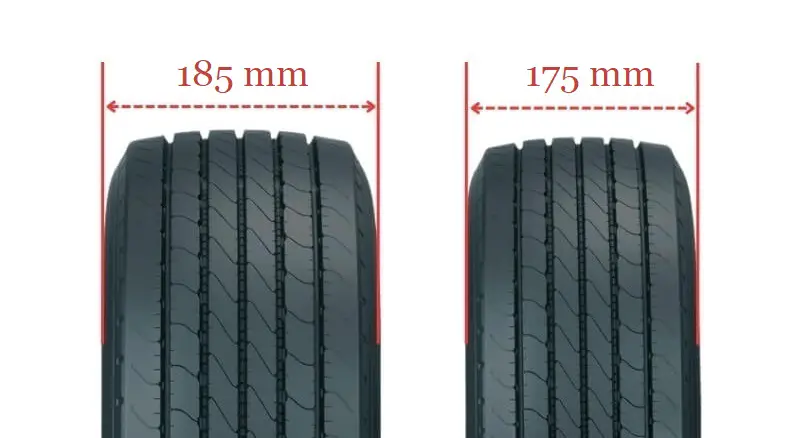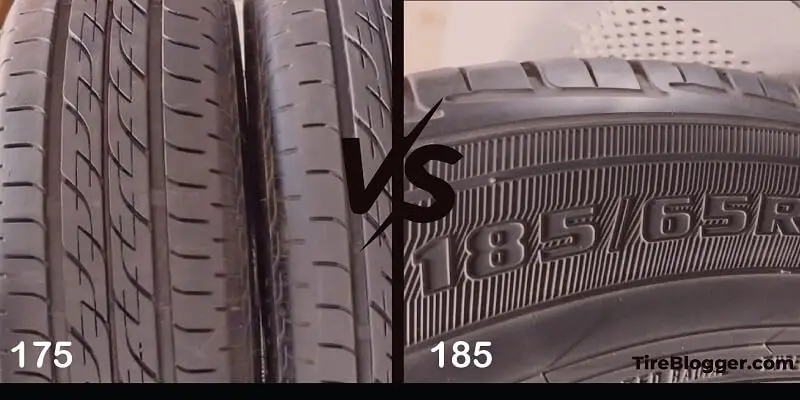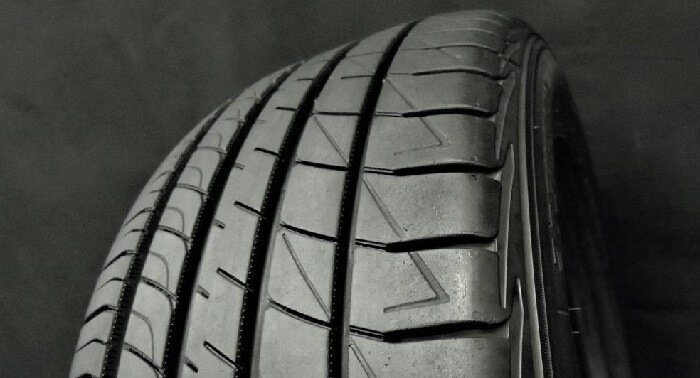175 vs 185 Tires

The main difference between 175 and 185 tires lies primarily in their width, with 175 tires measuring 6.89 inches (175 mm) across, while 185 tires stretch slightly wider at 7.28 inches (185 mm), a difference of 0.39 inches (10 mm).
185 vs 175 Table
In this table, we can get the details about how those tires are difference from one another.
| 175 Tire Size | 185 Tire Size |
|---|---|
| More comfortable ride | Maximum dry road traction |
| Generally less expensive | Better handling performance |
| Better traction in snow, rain, slush | Suitable for heavier loads |
| Improved fuel economy | More aesthetically pleasing |
| Recommended rim width: 5-6 inches | Recommended rim width: 5-6 inches |
| The 175 tire size is 10mm smaller than 185 tire size | The 185 tire size is 10mm larger than 175 tire size |
| Can replace 185 tire due to similar rim width range | Can replace 175 tire due to similar rim width range |
Ride Comfort
Ride comfort sees a slight shift between these sizes. The narrower 175 tires may offer a smoother experience on well-paved roads, thanks to their smaller footprint and reduced tendency to pick up road irregularities.
In contrast, the 185 tires, with their broader base, can absorb impacts better, providing a more comfortable ride on less-than-ideal surfaces.
Ground Clearance
Ground clearance is not directly affected by the width of the tires but rather by their overall diameter.
However, assuming identical diameters, the primary concern shifts towards how these widths can influence your vehicle’s ability to clear obstacles, with wider tires potentially offering a marginally better approach to navigating rough terrains.
Gas Mileage
In the battle for fuel efficiency, the narrower 175 tires take the lead. Their smaller contact patch and lighter construction contribute to less rolling resistance, translating into better gas mileage.
The wider 185 tires, on the other hand, might slightly reduce fuel efficiency due to increased rolling resistance and weight.
Aesthetics Look
Aesthetically, the choice between 175 and 185 tires might depend on personal preference and the vehicle’s design. The 185 tires offer a beefier look, potentially enhancing the vehicle’s aggressive stance and appeal.
Conversely, 175 tires maintain a more traditional appearance, complementing the aerodynamics and sleek lines of a vehicle.

Handling & Stability
Handling and stability see a nuanced difference between the two sizes. The narrower 175 tires might provide sharper handling and quicker response on asphalt, benefiting urban drivers and those who prioritize agility.
The 185 tires, however, offer increased stability and traction, especially on uneven surfaces or during off-road adventures.
Noise & Vibration
Noise and vibration handling can vary, with 175 tires likely offering a quieter ride on smooth roads.
The 185 tires, especially if equipped with aggressive tread patterns, might generate more noise but could also better dampen vibrations thanks to their larger air volume and sidewall height.
Durability & Wear
Durability and wear patterns might not significantly differ between the two, but the 185 tires’ wider footprint could potentially lead to more even wear over time. Yet, this can also depend on driving habits and tire quality.

Adverse Performance
In adverse conditions such as snow or mud, the performance gap becomes apparent. The 175 tires might navigate through snow more effectively, cutting to the road below.
While the 185 tires could provide better traction in muddy conditions, thanks to their wider surface area.
What Does 175 Mean On A Tire?
The first number in the series typically represents the tire’s width in millimeters. For example, in the case of 175, this number refers to the width of the tire from sidewall to sidewall.
Therefore, a tire with a width of 175 millimeters is more comprehensive than a tire with a width of 155 millimeters.
Difference Between 175 and 185 Tires
The main difference is width. 185 tires are 10mm wider than 175 tires. This affects performance, handling, and fuel efficiency. Wider tires generally provide better grip but may increase rolling resistance.
Can I Use 185 Tires Instead of 175?
Yes, it’s possible to switch from 175 to 185 tires. The ideal rim width ranges overlap, making it a suitable upgrade. However, ensure the aspect ratio and rim diameter match your current setup or stay overall diameter within 3% difference.
Can I Use 175 Tires Instead of 185?
Yes, you can use 175 tires instead of 185. The ideal rim width ranges overlap, allowing for this switch. Remember to match the aspect ratio and rim diameter, or keep the overall diameter difference within 3%.
Can You Put 185 Tires on 175 Rims?
Yes, you can put 185 tires on rims designed for 175 tires. The ideal rim width range for 175 tires (6.0-6.5 inches) overlaps with the range for 185 tires (5.5-6.5 inches), ensuring proper fitment and performance.
Can You Put 175 Tires on 185 Rims?
Yes, you can put 175 tires on rims designed for 185 tires. The ideal rim width range for 185 tires (5.5-6.5 inches) overlaps with the range for 175 tires (6.0-6.5 inches), allowing for safe installation.

Meet Caitlin McCormack, a Tire Size Expert and Blogger Passionate About Everything Related to Tires. With Years of Experience in the Tire Industry, Caitlin Has Become an Expert in Tire Sizes and Their Impact on Vehicle Performance.
